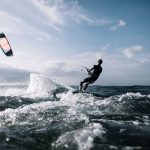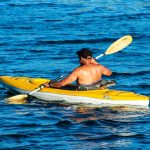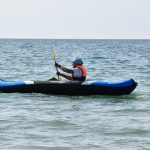Do you want to learn how to kayak, but don’t know where to start? Kayaking is good for both your body and your mind.
It’s a great way to get exercise, and you can see some beautiful scenery when you do it on lakes, rivers, or the open ocean.
At a distance, kayaking might look easy.
Even though it’s not difficult to learn, kayaking is more technical than canoeing. If you follow the proper procedures, your first kayaking experience will go smoothly.
We want to make your life easier by providing answers to the questions you ask most frequently about outdoor adventure sports.
Our guides can help people of all skill levels, from those who are just starting out to those who need to refresh their skills. Let’s dive in…
BEGINNER QUESTIONS
DO I NEED TO BUY A KAYAK BEFORE MY FIRST KAYAKING TRIP?
It’s best not to swim alone in unfamiliar waters. It’s best to either take lessons or rent equipment at a lake with a lifeguard on duty.
DO I NEED TO TAKE LESSONS?
It is not necessary, but we recommend that you do. Although your friends who own kayaks can take you out on the water, they may not be able to teach you the proper technique. Learning the proper technique is a big part of enjoying kayaking.
Many first-time kayakers use technique that strains their neck, back and arms. These errors eventually leave them feeling discouraged.
This is good advice for anything you attempt to do. You will be more successful if you do it right the first time.
I DON’T WANT TO TAKE LESSONS. WHERE CAN I RENT EQUIPMENT?
Most rental booths near lakes will have the equipment you need. The package provides the kayakers with a kayak each, some form of flotation device to keep them afloat and a double-sided paddle.
If you’re not comfortable kayaking on your own, some outfitters offer tandem kayak rentals so you can go together in one vessel.
Make sure the heavier person sits in the back. Also, never leave the shore if PFDs aren’t provided.
OUT ON YOUR OWN
WHERE SHOULD I GO ON MY FIRST TRIP?
It’s best to practice on lakes. Rivers can be overwhelming for people new to the sport if they have even a mild current.
After you’re comfortable hiking on your own, consider joining a group hike where the necessary equipment will be provided.
WHAT SHOULD I TAKE WHEN KAYAKING?
Make sure you bring plenty of water, a snack, sunscreen, a hat, and extra layers of clothing on your first trip, even if it’s just a lesson. Good habits last a lifetime.
Drybags are useful for keeping your cell phone or other electronics dry when you’re doing water sports or other activities.
Drybags are bags that are sealable and waterproof that are designed to keep your electronics and valuables safe in case the bag is exposed to water, like when your kayak tips over.
TECHNIQUES TO MASTER
HOW DO I GET IN AND OUT OF A KAYAK?
AT THE SHORE
Place your paddle across your kayak, a few feet in front of the seat, holding it in the center with one hand. Your other hand should be placed on either side of the kayak. Put your other hand on the back of the seat in front of you.
Your body should be anchored perpendicularly to the kayak. To get into the canoe, first step in with the foot that is closest to the seat. Sit down at an angle where you don’t have to adjust your feet to be comfortable. Adjusting your feet could rock the kayak.
rested my weight on the seat back and the paddle to get in the kayak.
AT THE DOCK
Find a place on the dock where the kayak is close to the dock, so you don’t have to step down far. Do not let go of the dock or the seat back. Step in at an angle and sit down smoothly.
If you find it difficult to imagine the situation described in the text, animations on entering and exiting a kayak are available on KayakPaddling.net.
WHAT IS THE PROPER PADDLING TECHNIQUE?
HOLDING THE PADDLE
Most paddles have the brand logo on one side and not the other. The brand logo should be visible from your seat in the kayak.
The longest edge of the paddle blade should be on top if you are holding the paddle correctly. The blade will be shorter on one side and have the brand logo printed on it.
USE YOUR CORE
It is important to realize that the best paddlers use the least energy. Sit up straight and face forward. Make sure your hands and wrists are in line with your arms.
Place your hands on the paddle so that they are about shoulder-width apart and an equal distance from the center of the paddle on both sides. Over-gripping will waste energy.
Since your core is stronger than your arms, you should primarily use your core when making strokes. This will help you last much longer. Rotate your torso from left to right while maintaining bent and fixed arms.
Make sure that your back is against the seat so that you have proper balance, do not overstretch, and do not waste energy.
If you sit too far forward in your kayak, it will be easier to tip over and you will get tired quickly from having to use your arms to stabilize your weight.
MAKE A STROKE
To start, rotate your body to the right while reaching forward with the left side of the paddle. Stop when you are at about 50 percent extension. This will ensure that you get the most power possible when paddling. Be sure to dip the paddle blade into the water no more than halfway up the blade to get the most power possible.
Place your hand on the side of your head and pull it firmly back while rotating your torso to the other side. Your left paddle blade should come out of the water at your hip line.
The paddle blade on the right side should immediately enter the water on the opposite side, repeating the progression.
HOW DO I TURN AROUND IN A KAYAK?
There are three ways to turn around in a kayak. The first way to steer the canoe is to use the paddle as a rudder. To turn a moving kayak, dip the blade of the paddle into the water on the side of the direction you want to turn.
Drag the paddle through the water until the kayak starts to turn.
To turn the boat around, you can use the pedals on both sides of the boat. These pedals power a rudder located at the rear of the boat. This works like the previous method described.
Reversing your stroke is another way to turn your boat around. To turn the kayak, paddle backwards on the desired side.
How to Kayak 101 – Get a Boat
A boat is necessary before venturing out on the waters. But, not just any boat – a kayak. If you don’t have anyone in your life that has a kayak, a great place to start would be to borrow one from a friend.
An on-the-water outfitter is a place where you can rent a kayak and all the gear you would need for your expedition. It is the most affordable way to try kayaking before investing a lot of money in equipment.
Another option for enjoying the lake would be to sign up for a tour. If you purchase this package, you will receive a yak, gear, and all the essentials you need.
Your last option would be to sign up for a kayaking class. A tour with more in-depth instruction.
The goal of all this is to get into a boat and go out on the water to experience the sport.
You could also just go ahead and buy a kayak right away. If you want to do something and you’re committed to it, then go for it.
Did you know that there are different types of kayaks for different styles of kayaking? It’s true! If you are just beginning your kayaking journey, don’t worry about spending a lot of money on multiple kayaks. Before getting started, you should determine what type of kayak you need.
How Do I Choose the Right Kayak?
A road bike is a good choice if you’re planning to stick to roads. A mountain bike will be necessary if you wish to downhill bike. If you want to stick to trails and commuting, then a hybrid bicycle is your best option.
Kayaks are similar in this sense. Here are the 5 main kayak types you need to know:
Sit-on-top kayaks are the most common type of recreational kayak. They are easy to get in and out of and are usually wider, which makes them more stable. Great for beginners.
translatable kayaks are a lot like sit-on-top kayaks, except they’re much easier to to take with you because you can inflate and deflate them.
Better used for relaxed, shorter rides in calm waters. An inflatable kayak would be a good choice for someone who is skeptical about kayaking but wants to try it.
Recreational kayaks are designed for larger seating areas and shorter in length compared to those designed for other purposes. They are great for recreational use and provide a fun way to enjoy the outdoors.
This is a good option for people who are beginners or just want to have fun in the water.
Touring kayaks: These are longer, much more narrow, and have a small seating area. Great for longer trips and easy to use.
Whitewater kayaks are for people who are more experienced in kayaking. They have different options depending on how much experience the kayaker has. If you want a more intense ride through rougher waters, you should get a whitewater kayak.
They are more versatile and can handle more difficult conditions.
What is the Basic Gear I Need to Go Kayaking?
In addition to a kayak, you will need a few other things to get started. The type of gear and supplies you need for your kayaking trip will depend on the kind of trip you are taking.
Here is a list of some of the basics you will need and some information on each item. Plan ahead for your kayaking adventure by packing enough supplies, including food and water.
Depending on the severity and length of your trip, you may need more or less supplies.
A paddle is an essential piece of equipment when you go kayaking. There are a few things you should take into account when choosing a paddle, like the size of your kayak and what type of kayaking you plan on doing.
If you’re kayaking, it’s important to wear the right personal flotation device. Although it can be enjoyable to paddle around in open water, it is always most important to prioritize safety, especially when you are kayaking alone.
You need to find a personal flotation device that is right for your body type.
A device used by all kayakers to empty water out of the kayak if it starts taking on too much water. The purpose of a bailer is to remove water from your kayak, so depending on the location or severity of the water, you may not need to use it.
However, it’s still important to bring one just in case.
Adjust Your Kayak
Remember that you should feel comfortable inside the boat. This means that you should take the time to plan out your route before you start driving. You should take the time to plan your route before driving since you will be spending several hours on the road.
The key to a pleasant on-water experience is having a well-adjusted kayak. Before you launch your boat into the water, here are some things you should do.
- While the boat is on dry land, start by planting your butt firmly against the seat. Fine-tune the seat angle to a position that feels the most comfortable to you. Angling it upright will give you more power and balance, though.
- Next, place your feet on the foot pegs checking to see that your knees are slightly bent. Slide the foot pegs along their track to their preset stopping points to ensure that you achieve the desired angle.
- Finally, ensure that each top of your bent knee is in contact with each side of the cockpit. This is important for having total control over the kayak’s side to side motion. This, however, doesn’t mean that they should be jammed in there to the point you wouldn’t be able to easily get out of the boat in an emergency.




